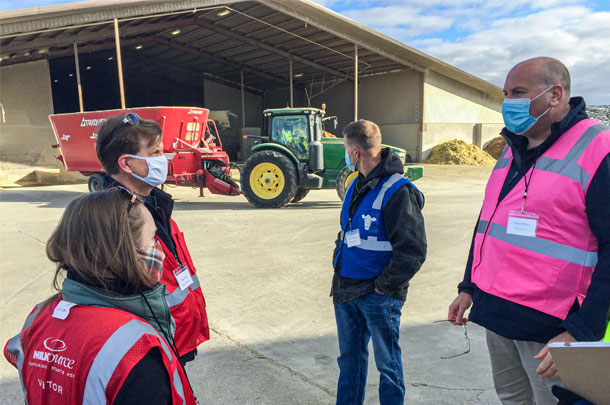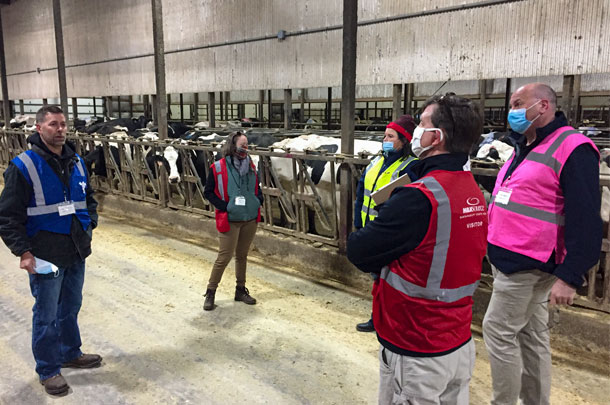Several representatives of federal agencies with environmental and water quality oversight visited Wisconsin in late October, with stops at two dairy farms: Miltrim Farms, Athens, and Rosendale Dairy, Pickett. Participants included U.S. Department of the Interior representatives Timothy Petty, assistant secretary for water and science, and Aubrey Bettencourt, deputy assistant secretary of water and science; and U.S. Environmental Protection Agency (EPA) Assistant Administrator David Ross and Jess Kramer, policy counsel.
The tours and discussions were held to build relationships between government officials charged with writing and implementing water-quality regulations and dairy producers striving to implement best management practices while profitably operating their farms and businesses.

Ostrom: Sustaining agriculture through generations
The 9,000-cow Rosendale Dairy is one of several farms owned by Milk Source, a partnership between Jim Ostrom, John Vosters and Todd Willer. The trio and other staff members provided tours of the dairy, discussing animal management, feeding, manure and water management practices.
Despite its size, the focus of Rosendale Dairy and Milk Source remains that of a “family farm,” Ostrom said. “I can tell you to our core [that we] see ourselves as family farmers. We think in terms of generations: How can we get our next generation to evolve so that our business can be part of agriculture going forward.”
While nutrient management of dairy farms often focuses on manure application, Ostrom stressed that the focus should be on nutrient balance and runoff.
Ostrom’s “epiphany” occurred several years ago, based in part to economics. He determined that transportation costs related to crop harvest and manure application were economically feasible within a 10-mile radius. Within that distance of Rosendale Dairy rests about 100,000 acres of tillable farmland. By managing an ecosystem that buys or harvests crops and returns dairy manure nutrients to the soil – replacing chemical fertilizers – the farm is contributing to the economic, environmental and social sustainability of the area, he said.
Ostrom has seen a shift in environmental-responsibility culture among dairy producers, who no longer race through environmental compliance.
“Instead of crossing our arms and saying [to regulators], ‘Stay off my farm,’ let's figure this out together,” he said. “That's the culture we've got to have.
“We have a tremendous responsibility to be in high compliance environmentally,” Ostrom said. “Our culture and objectives are more than regulation; it's truly to do the right thing. The vast majority of farms I know are on that same page about doing great things. They care about their animals; they care about the people; they care about their environment.”

Regulatory culture changing
While the environmental culture among dairy farmers is evolving, so must it adjust among regulators, said EPA’s Kramer. In the past, regulators may have based policy decisions on models and “guidance documents” far removed from practical on-farm applications, she said. The cultural shift must include science-based decisions and recognize the checks and balances of government.
While dairy farm family decisions are frequently based on generational needs, government and regulatory timelines are shorter, sometimes limited to election-year cycles. Government agency staffers who work through political leadership changes must attempt to “institutionalize good practices” when they have the opportunity, regardless of the election outcome, Kramer said.
“You go into these positions knowing that you have a set amount of time, and you pick the areas that you want to focus on the most,” she said. “What we're really looking for is good government transparency … instead of expanding your regulatory authority through guidance. You do your best to do that.”
Executive order creates water subcabinet
Petty summarized an executive order, signed by President Trump on Oct. 13. The “Modernizing America’s Water Resource Management and Water Infrastructure” order established a “water subcabinet” of federal agency officials, with the charge of modernizing and improving the efficiency and effectiveness of water supply and quality management in the U.S.
The water subcabinet is co-chaired by Interior Secretary David Bernhardt and EPA Administrator Andrew Wheeler and includes senior officials from the USDA, the Department of Commerce, the Department of Energy (DOE) and the Department of the Army (Civil Works).
Under the executive order, the subcabinet will:
- Promote effective and efficient water resource management by reducing duplication between federal agencies developing water policy;
- Develop a national water strategy to ensure the reliability of our water supplies, water quality, water systems and water forecasting;
- Protect taxpayer investments and improve water infrastructure planning by promoting integrated planning and coordination for drinking water, wastewater, water reuse, water storage and delivery, and water resource management; and
- Support and enhance workforce development to recruit, train and retain water sector professionals.
See the executive order and a fact sheet at these links.
The subcabinet is an outgrowth of a regional pilot project created to collaborate federal, state and local efforts on water issues in the western U.S. Petty called that pilot “phenomenally successful” by getting agencies to start from a common baseline and then work together.
Regional and local water concerns differ, and the focus of the October tour was the Midwest – heavily populated by farms within the Great Lakes and the Mississippi River basins.
An outgrowth of the collaboration between government agencies is an effort to involve private equity to help finance or create markets for things like manure digesters and wetland restoration.
There’s a new app
Petty also previewed the completion of a new U.S. Geological Survey National Water Dashboard, announced Oct. 30. The new mobile tool provides real-time water-related information on a computer, smartphone or other mobile device. That information will help forecasting, response and recovery efforts for agencies such as the National Weather Service, the Federal Emergency Management Agency, the U.S. Army Corps of Engineers and other federal, state and local agencies. The dashboard will also assist the U.S. Army Corps of Engineers as they manage water supplies in river basins and operate flood-control reservoirs. During a drought, the tool can help state resource managers identify areas where water supplies are at risk.
“The National Water Dashboard is a much-needed advancement that will help keep communities across the country safe during extreme weather conditions,” said Petty. “The development of a comprehensive tool that can provide real-time, critical information on mobile devices is great news for areas in our country that are prone to flooding or drought. In addition to giving the public key information on what’s happening in their communities, it will also help improve the response of federal, state and local agencies during storms, floods and drought conditions. ![]()
PHOTO 1: Representatives of federal agencies with environmental and water quality oversight visited Rosendale Dairy, Pickett, Wisconsin, in late October. Participants included U.S. Department of the Interior and Environmental Protection Agency representatives (left to right): Aubrey Bettencourt, Timothy Petty, David Ross and Jess Kramer.
PHOTO 2: Rosendale Dairy co-owners Todd Willer and John Vosters discussed feed, animal care and nutrient management practices with Timothy Petty and Jess Kramer.
PHOTO 3: Rosendale Dairy’s John Vosters (far left) described the dairy’s cross-ventilated barn to tour participants. Photos by Dave Natzke.

-
Dave Natzke
- Editor
- Progressive Dairy
- Email Dave Natzke






